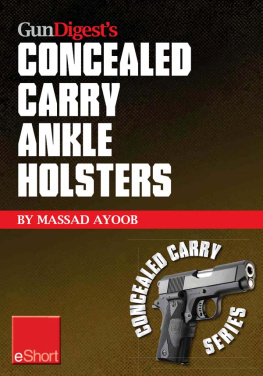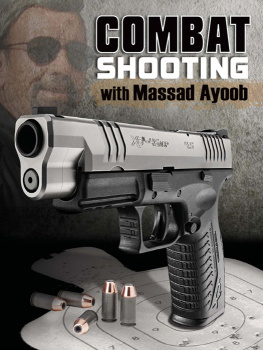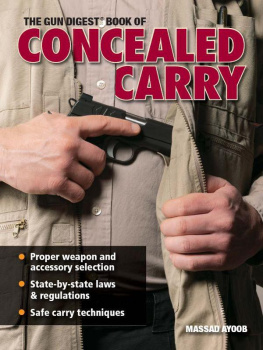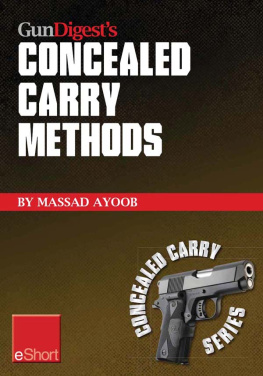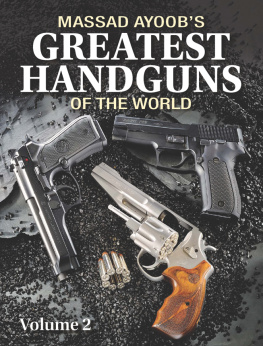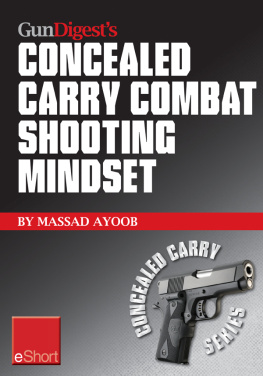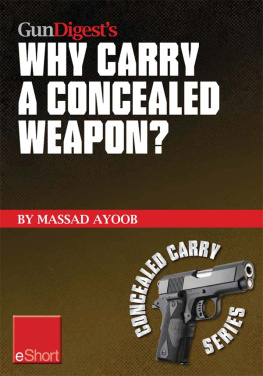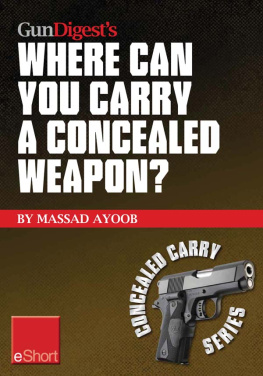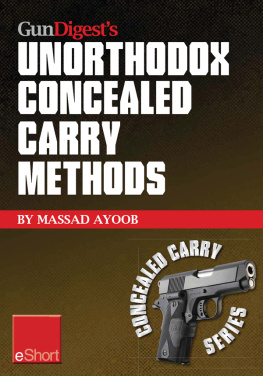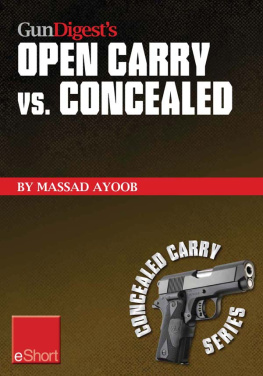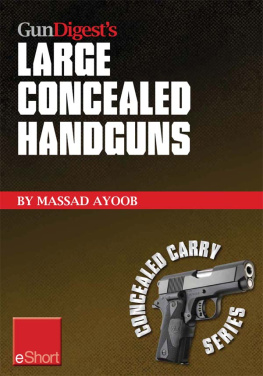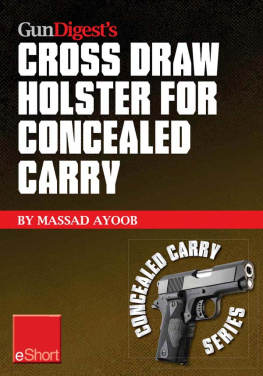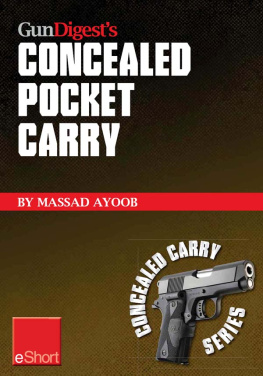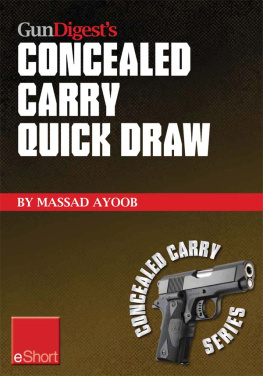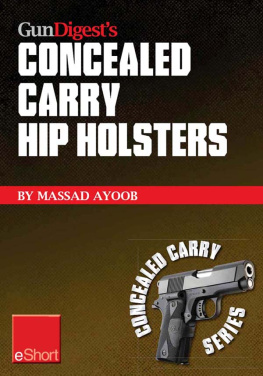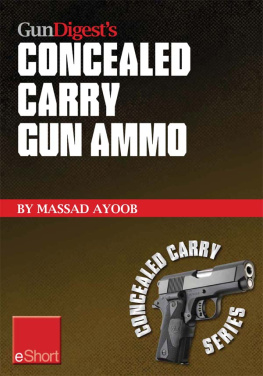Massad Ayoob - Gun Digests Concealed Carry Ankle Holsters eShort
Here you can read online Massad Ayoob - Gun Digests Concealed Carry Ankle Holsters eShort full text of the book (entire story) in english for free. Download pdf and epub, get meaning, cover and reviews about this ebook. year: 2012, publisher: F+W Media, genre: Detective and thriller. Description of the work, (preface) as well as reviews are available. Best literature library LitArk.com created for fans of good reading and offers a wide selection of genres:
Romance novel
Science fiction
Adventure
Detective
Science
History
Home and family
Prose
Art
Politics
Computer
Non-fiction
Religion
Business
Children
Humor
Choose a favorite category and find really read worthwhile books. Enjoy immersion in the world of imagination, feel the emotions of the characters or learn something new for yourself, make an fascinating discovery.
- Book:Gun Digests Concealed Carry Ankle Holsters eShort
- Author:
- Publisher:F+W Media
- Genre:
- Year:2012
- Rating:3 / 5
- Favourites:Add to favourites
- Your mark:
- 60
- 1
- 2
- 3
- 4
- 5
Gun Digests Concealed Carry Ankle Holsters eShort: summary, description and annotation
We offer to read an annotation, description, summary or preface (depends on what the author of the book "Gun Digests Concealed Carry Ankle Holsters eShort" wrote himself). If you haven't found the necessary information about the book — write in the comments, we will try to find it.
In this excerpt from the Gun Digest Book of Concealed Carry, Massad Ayoob shows how to draw and fire using an ankle holster, plus gun choice considerations and the rationale of ankle carry.
Gun Digests Concealed Carry Ankle Holsters eShort — read online for free the complete book (whole text) full work
Below is the text of the book, divided by pages. System saving the place of the last page read, allows you to conveniently read the book "Gun Digests Concealed Carry Ankle Holsters eShort" online for free, without having to search again every time where you left off. Put a bookmark, and you can go to the page where you finished reading at any time.
Font size:
Interval:
Bookmark:

Gould & Goodrich ankle holster shown w/baby Glock.
I had the privilege of knowing the late George C. Nonte, Jr. The man knew his guns, and he had broad connections with others in the industry and in the field who knew their guns, and he funneled that knowledge into his work. In his last book Revolver Guide, published posthumously by Stoeger George told the following tale that highlights the wisdom of carrying a spare gun south of ones bodys own middle border.
Many uniformed officers consider a belly gun as much a part of their equipment as a nightstick or cuffs. And, if the truth be known, the belly gun is not always employed in the singular. An example of the plural might well be a Texas Ranger known to me, who got just a wee bit careless or unlucky one day when entering a building after a felon. Somehow the black-hat got the drop on him and relieved him of his main six-gun. Eventually an opportunity presented itself, and the Ranger whipped out his belly gun and ventilated his unfriendly assailant.
Later he was asked somewhat jokingly, What would you have done if he had found your hideout gun, too? His response was not entirely unexpected, but might be just a slight shock to those whove never had to depend upon a gun for their lives Well, he said, Id probably have shot him with this one, and slipped yet another two-inch 38 out of his boot top.
Theres a lot of lore and wisdom in those couple of short paragraphs by the late Brother Nonte. Note that the boot top was the Rangers choice for his snub-nose 38. It is safe to assume that horsemen prepared for trouble have been stuffing handguns down in their boot tops since the time of the earliest match-lock pistols. The spot was thereit was handy to a man astride a horseand it kept belt space free for more equipment, including another handgun.
Why are ankle holsters popular today, when were more likely to ride the family automobile (or a Police Interceptor) than something with hooves? For much the same reasons. The spot is thereits handy to a seated individualand it keeps belt space free for more equipment, including another handgun.
The rise of the ankle holster can be tracked through the history of 19th, 20th, and 21st Century America. 1934: Eugene Cunningham saw publication of his book Triggernometry, a study of the guns, gear, and gunfighters of the Old West. He noted that despite the movie image of big six-shooters swinging openly on hips, many Western towns prohibited the carrying of guns, and a man who wanted to be armed needed deep concealment. Said Cunningham, The hide-outs were various. A man rammed his six-gun into the leg of his boot just in case something came up, in which hed want to gain what was lost in the deal by what he could do on the draw.
1960: In his classic book Handgunners Guide, Chic Gaylord wrote, To be effective, the undercover holster should carry the gun in a position on the body that cannot be detected by the bump frisk often employed by hoodlums or their girl fiends. Shoulder holsters and belt holsters are too easily detected by a few pseudo-amorous passes. The holsters position should also enable its wearer to reach the gun with reasonable speed.

gun hand contacts pistol, thumb breaking safety strap of Gould & Goodrich ankle rig
Added Gaylord, The best of all undercover holsters is the ankle holster. Guns the size of the Chief Special or the Detective Special are easily and effectively hidden in this manner. It is an extremely comfortable holster even after as much as eighteen straight hours of wear. You can draw a gun from this rig while seated in a car or in a tavern far faster than from any other type of holster. When seated at a table, the gun can be drawn and held at ready with no one the wiser in case of impending danger. Its ready accessibility counts heavily when you are wearing an overcoat; and when standing you can draw it nearly as fast as from a belt holster. Many a New York City police officer uses this rig while on duty in uniform. When jumped by a mob of hoodlums and knocked to the ground, he can draw his gun faster than from a belt holster. One of the advantages of this holster is that the officer can wear jeans and a skivvy shirt without fear of being made.
1986: In the second edition of Blue Steel and Gunleather by John Bianchi, it is observed that ankle holsters have grown enormously in demand in recent years. Many off-duty police carry a gun under the trouser leg, usually a small-frame, hideout piece. The handgun is well concealed in the lower body extremities, but it is not readily accessible, even from a seated position. Practice in drawing the gun with this system improves the efficiency for the draw and fire. It is recommended primarily as a second gun carry for both uniform and plainclothes situations.
At this writing, ankle holsters remain popularand the guns carried there have gotten bigger. I can think at the moment of two state patrols who issue their troopers baby Glock pistols with ankle holsters, and expect them to be carried daily as backup when in uniform. One such agency issues the troopers Glock 39 pistols in caliber 45 GAP, to back up the full-size Glock 37 pistols in the same caliber that ride in their uniform holsters. That agencys issue backup holster is currently an ankle rig with thumb-break retainer by Gould & Goodrich. The other agency had been issuing 380 automatics with ankle holsters for years, but was not happy with their reliability. The department adopted Glock 27 pistols, caliber 40 S&W, and issued them with ankle rigs, the brand of which escapes me at the moment. The little 40 Glocks worked out so well that when that departments heavy 10mm Smith & Wesson service pistols were due to be replaced, the department traded them in on Glock 35 pistols with 5.3-inch barrels. The latter guns 15-round 40 magazines will work in the G27 subcompact model, just as the full-length magazines of a G37 will work in the chopped and channeled version, the G39. In either case, a trooper whose primary Glock is snatched, inaccessible, or shot out of his hand still has another Glock in the same caliber, and two spare magazines on his duty belt, with which to continue the fight.
One reason for the rising popularity of the ankle holster can be summed up in a single word: Velcro. When I was a kid, ankle holsters were available but uncommon. One company, Legace, made one with little straps and buckles. If your ankle diameter wasnt exactly right for one tongue and loop combination of that set-up and if it was uncomfortable for you to put it on one notch loose and pad the inner circumference by wearing an extra sock it just wasnt going to work for you. Too tight restricted circulation unmercifully, and too loose was almost as painful, with the chafing that occurred as the sloppy-fitting rig bounced all over the place with every step you took, not to mention problems with concealment.
I recall seeing one ankle holster of the period I forget the brand that secured with lacings and grommets, like a shoe. Trouble with that was the same as with shoelaces: they could become untied. There was also the problem of a lace dangling below a trouser cuff giving away the hidden holster.
Velcro changed all that. It allowed the holster to be adjusted for pretty much perfect fit. Along about the 70s. a lot of thought went into a rig called the Milwaukee Legster. Velcro secured the regular ankle rig in the usual location, but a strap ran up from it to another Velcrod strap that encircled the leg between the knee and the calf muscle. This gave a suspension effect that helped hold the rig in place to keep it from shifting around.
Font size:
Interval:
Bookmark:
Similar books «Gun Digests Concealed Carry Ankle Holsters eShort»
Look at similar books to Gun Digests Concealed Carry Ankle Holsters eShort. We have selected literature similar in name and meaning in the hope of providing readers with more options to find new, interesting, not yet read works.
Discussion, reviews of the book Gun Digests Concealed Carry Ankle Holsters eShort and just readers' own opinions. Leave your comments, write what you think about the work, its meaning or the main characters. Specify what exactly you liked and what you didn't like, and why you think so.

